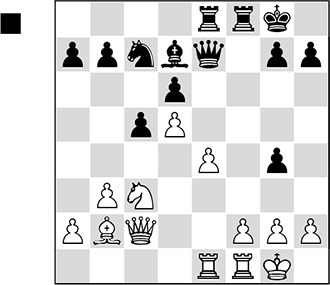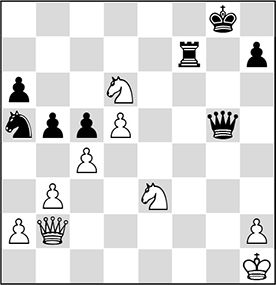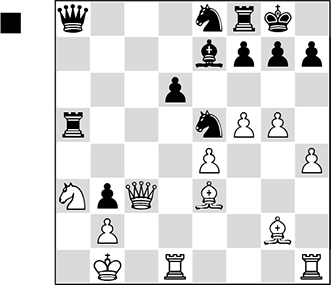Chapter 45
Bringing unused pieces into the attack
One of the main reasons why an attack can fail to achieve its aim is the banal one of a simple insufficiency of fighting units in the main battle zone. When one has pieces that are badly placed and not participating in the main action, one must seek a favourable way of bringing them into the attack. If part of one’s forces are not participating, an attack will as a rule fail. Bringing unused pieces into the attack, or using them as a deflection in another part of the board, can be an effective way of strengthening an attack, and frequently brings success.
272 *
Artur Jussupow
2575
Robert Morenz
Graz tt 1981

White has extra material, but his king is not safe and the ♖a1 is hanging. The only way to decide the game is to bring the kingside pieces into play:
13.♕b3!
The only move! Bad is 13.♖b1? ♕d3+.
Other moves do not win:
A) 13.♘f3 ♕d3+ 14.♔e1 ♗g7 15.e5 ♕c3+ 16.♔e2 ♕d3+=;
B) 13.♕b5 ♕xa1 14.♗xd7+ ♖xd7 15.♕b8+ ♖d8 16.♕b5+=;
C) 13.♗xd7+ ♖xd7 14.♕b3 ♕xa1 15.♗b2 ♕b1 16.♕b8+ ♖d8 17.♕b5+ ♖d7=.
13…♕xa1
13…♕xb3 14.♗xd7++–.
14.♗b2
Bringing in the bishop, at the cost of the ♖a1!
14…♕b1

15.♘f3!
And now, bringing the knight into the attack, at the cost of the other rook!
15…♕xh1 16.♘e5
The white pieces that remain on the board break through to the black king.
16…e6
He also loses after 16…♕d1+ 17.♕xd1 ♗xc6 18.♕b3.
17.♗xd7+ ♖xd7
17…♔e7 18.♕b7+–.
18.♕b8+ ♖d8
18…♔e7 19.♘c6#.
19.♕b5+ ♔e7 20.♕b7+ ♔f6 21.♕xf7+ ♔g5 22.♘f3+
Black resigned, because of 22…♔h5
(nor is there any help from 22…♔h6 23.♕f4+ ♔h5 24.♕g5#) 23.g4+ ♔xg4 24.♕xe6+ ♔h5 25.♕h3#. The black pieces, standing on the edge of the board, are mere spectators.
[Translator’s Note: To be strictly fair, it should be pointed out that, as explained by Mark Dvoretzky in one of his books, this entire game was familiar to Jussupow beforehand, having been played years earlier in a simultaneous display (!) by the great tactician, Rashid Nezhmetdinov.]
273 **
Alexander Kotov
Mikhail Botvinnik
Moscow 1947 (4)

17…♘b5!
Bringing the passive knight into the game.
18.f4?
White had to cover the d4-square: 18.♘b1! ♘d4 19.♗xd4 cxd4 20.♕d3 a6 21.a4 ♕e5 22.♘d2 b5 23.g3∞.
18…gxf3 19.♖xf3
White had evidently overlooked that after 19.♘xb5 fxg2! 20.♖xf8+ ♖xf8, he cannot save the knight on b5: 21.♘c3? ♗h3–+.
19…♖xf3 20.gxf3 ♘d4
The black knight has transferred from c7 to d4, creating strong threats on the kingside.
21.♕g2 ♖f8 22.♖f1 ♕h4 23.♕g3 ♕xg3+
A technical decision in Botvinnik’s style. Black goes into an endgame with an extra pawn.
A tactician would have decided the game in the following fashion: 23…♕h5!? 24.f4 ♖f6 25.f5 ♗xf5 26.exf5 ♘xf5, with a winning attack.
24.hxg3 ♗h3 25.♖f2 ♘xf3+ 26.♔h1 ♘d4
26…a6! 27.♘d1 b5 .
.
27.♖xf8+ ♔xf8 28.♔g1 ♔e7
Black has an extra pawn and great winning chances, although subsequently, he failed to cope with the technical problems, and the game ended in a draw.
274 **
Tigran Petrosian
Boris Spassky
Moscow Wch match 1966 (10)

21.♘e3!
In one move, White brings two pieces into the game. Now, the decisive factor is the ♘a5, which occupies an absolutely prospectless position.
21…♗xf1
In the ending arising after 21…♖xf4 22.♖xf4 ♕g5+ 23.♖g4 ♗xg4 24.♘xg4 ♘xg4 25.♗xg4 ♕xg4+ 26.♔h1 ♕d4 27.♖g1+ ♔h8 28.♕xd4+ cxd4 29.♘e4 (the rook ending arising after 29.♖d1 bxc4 30.♘xc4 ♘xc4 31.bxc4 ♖b8 32.♖xd4 is full of nuances, and it is far from easy for Black to draw) 29…♘b7 30.♖d1 bxc4 31.bxc4 ♖f8 32.♔g2 ♖f4 33.♖e1, White retains the advantage – the pawn on d4 will soon be lost.
22.♖xf1 ♘g6
22…♘d7 23.♘e4 ♕e7 24.♗g4 (White also has a large advantage after 24.♗d3 ♕g7+ (otherwise, White carries out a decisive attack on the g-file) 25.♕xg7+ ♔xg7 26.cxb5 axb5 27.♗xb5 – for the exchange, White also takes a third pawn on d6) 24…♕xe4 25.♗e6+ ♖f7 26.♘f5 ♕xf5 27.♗xf5 ♖xf5 28.♖f3 – the white queen should be able to cope with the scattered black pieces.
23.♗g4 ♘xf4?
Losing at once, but the endgame arising after 23…♕f6 24.♗e6+ ♔h8 25.♕xf6+ ♖xf6 26.f5 ♘e5 27.♘e4 also promises nothing good.

24.♖xf4! ♖xf4 25.♗e6+ ♖f7 26.♘e4 ♕h4
26…♖aa7 27.♘f5+–.
27.♘xd6 ♕g5+ 28.♔h1 ♖aa7 29.♗xf7+ ♖xf7

30.♕h8+!
Black resigned.
275 ***
Viswanathan Anand
2715
Gata Kamsky
2695
Linares 1994 (1)

We have a variation of the Sicilian with opposite-side castling. Time is especially important in such positions.
22.♗d3!
White brings the bishop onto the working diagonal d3-h7, but even more important, he prepares to take on g1 with the rook, bringing it into the attack on the king.
After 22.exf6 ♕xf6 23.♕xg1 ♕xf4+ 24.♔b1 ♕xh4!, an unclear position arises.
22…♗xe5
After 22…♗xh4 23.♖xg1 g6 (23…g5? 24.♕g4 creates a threat against h4: 24…♔h8 25.♕f5+–) 24.♗xg6 ♔h8 25.♗h7 ♗f6 (25…♖g8 26.♗xg8 ♕xg8 27.♕h1 ♕d8 28.♖g4+–), White plays 26.♘c5!, including in the attack the ‘sleeping’ knight on a4 (26.exf6 ♕xf6 27.♗d3 ♖g8∞), 26…♔xh7 27.♘e6 ♕e7 (27…♖g8 28.♕e4+ ♔h8 29.♖h1 fxe6 30.♖xh6+ ♔g7 31.♕h7+ ♔f8 32.♖xf6+ ♕xf6 33.exf6 ♖e8 34.♕a7 ♖g6 35.♕xd4
(27…♖g8 28.♕e4+ ♔h8 29.♖h1 fxe6 30.♖xh6+ ♔g7 31.♕h7+ ♔f8 32.♖xf6+ ♕xf6 33.exf6 ♖e8 34.♕a7 ♖g6 35.♕xd4 ) 28.exf6 ♕xf6 29.♕e4+ ♔h8 30.♖g7 ♕xg7 31.♘xg7 ♔xg7 32.♕xd4+ ♔h7 33.♕xb4 – White retains some advantage in the endgame.
) 28.exf6 ♕xf6 29.♕e4+ ♔h8 30.♖g7 ♕xg7 31.♘xg7 ♔xg7 32.♕xd4+ ♔h7 33.♕xb4 – White retains some advantage in the endgame.
23.fxe5 ♕xh4 24.♖xg1 ♕f4+

25.♔b1!
It was worth considering 25.♕d2, with a variation such as 25…♕xe5 26.♘b6! (White’s prospects in the endgame are unclear: 26.♕xh6 ♕e3+ 27.♕xe3 dxe3 28.♔d1 ♖fe8) 26…♖ad8 27.♘c4 ♕e6 28.♕xb4. With queens on, Black cannot advance his kingside pawns, as this weakens his king too much.
25…♕xe5 26.♘c5
The knight comes into play with decisive effect.
26…♖a7
After 26…♖fd8, White begins a strong attack: 27.♘d7 ♕g5 28.♕f1 ♕e3 29.♘f6+ ♔h8 30.♕g2 ♕g5 31.♕xg5 hxg5 32.♖h1#.
Whilst after 26…♖ad8, he can take the black pawns: 27.♘xa6 ♖a8 28.♘xb4 .
.

27.♕c6! ♕e3
Other possibilities:
A) 27…♖e8 28.♘d7 ♕e3 29.♘f6++–;
B) 27…♔h8 28.♘d7 ♕e3 29.♖g2 ♖d8 30.♖xg7! ♖axd7 31.♕f6+–.
28.♖g2 ♔h8 29.♖e2 ♕g1+ 30.♔a2 ♖aa8 31.♘d7 ♖ac8
A) 31…♖fd8 32.♘e5+–;
B) 31…♖fc8 32.♕f3+–.
32.♕f3
The white pieces are gathered for a decisive attack on the king.
32…f5 33.♘xf8 ♖c5 34.♘g6+
He wins beautifully after 34.♕xf5 ♖xf5 35.♗xf5 ♕f1 (35…g5? 36.♖e7+–; 35…♔g8 36.♗g6!+–) 36.♘g6+! ♔h7 37.♘h4+ ♔g8 38.♖e8+ ♔f7 39.♗g6+ ♔f6 40.♖f8++–.
34…♕xg6
34…♔h7 35.♖e5+–.
35.♖e1 ♕f6 36.♕a8+ ♔h7 37.♗c4 ♖c6 38.♕g8+ ♔g6 39.♖g1+
Black resigned.
At the top level, there is no need for the additional moves 39…♔h5 40.♗e2+ ♔h4 41.♕d5, with unavoidable mate.
276 ***
Sergei Karjakin
2660
Viswanathan Anand
2792
Wijk aan Zee 2006 (1)

The position is improbably sharp and at first glance hard to assess. White’s king is exposed, but his greater space and advanced kingside pawns seriously cramp Black, and represent a potential threat. One way or another, the active black pieces are insufficient to carry out an attack, and he needs to bring up his reserves. This is impossible to do without sacrifices, so…
24…♘c7!!
If this move were not available, Black would have to play 24…♘f6!? 25.gxf6 ♗xf6 26.♗d4 ♖c8, retaining strong compensation for the pawn.
25.♕xc7
He loses immediately with 25.♗b6 ♖xa3 26.bxa3 ♘b5.
25…♖c8! 26.♕xe7
26.♕b6 allows the knight to be brought up with tempo.

26…♘c4!
If 26…♖xa3?? 27.bxa3 ♕xa3, the white queen manages to return to the defence: 28.♕a7!.
27.g6
This attempt at counterplay fails, but going over to defence also loses:
A) 27.♗c5 ♖xa3 28.bxa3 ♖xc5 29.a4 ♘a3+ 30.♔b2 ♖c2+ 31.♔xa3 ♕b8! 32.♖a1 b2;
B) 27.♗d4 ♖xa3 28.bxa3 ♘xa3+ 29.♔b2 ♘c4+ 30.♔c3 (30.♔xb3 ♕a3+ 31.♔c2 ♘e3+ 32.♔d2 ♖c2+ 33.♔e1 ♕b4+) 30…♕a2 31.♗c5 ♕c2+ 32.♔d4 dxc5+ 33.♔d5 ♘e3+ 34.♔d6 ♘xd1.
27…hxg6 28.fxg6 ♘xa3+
Also winning is 28…♖xa3 29.♕xf7+ ♔h8 30.bxa3 ♘xa3+ 31.♔b2 ♘c4+ 32.♔c3 ♘e5+.
29.bxa3 ♖xa3 30.gxf7+ ♔h7 31.f8♘+ ♖xf8 32.♕xf8 ♖a1+ 33.♔b2 ♖a2+ 34.♔c3 ♕a5+ 35.♔d3 ♕b5+ 36.♔d4 ♖a4+ 37.♔c3 ♕c4+
White resigned.